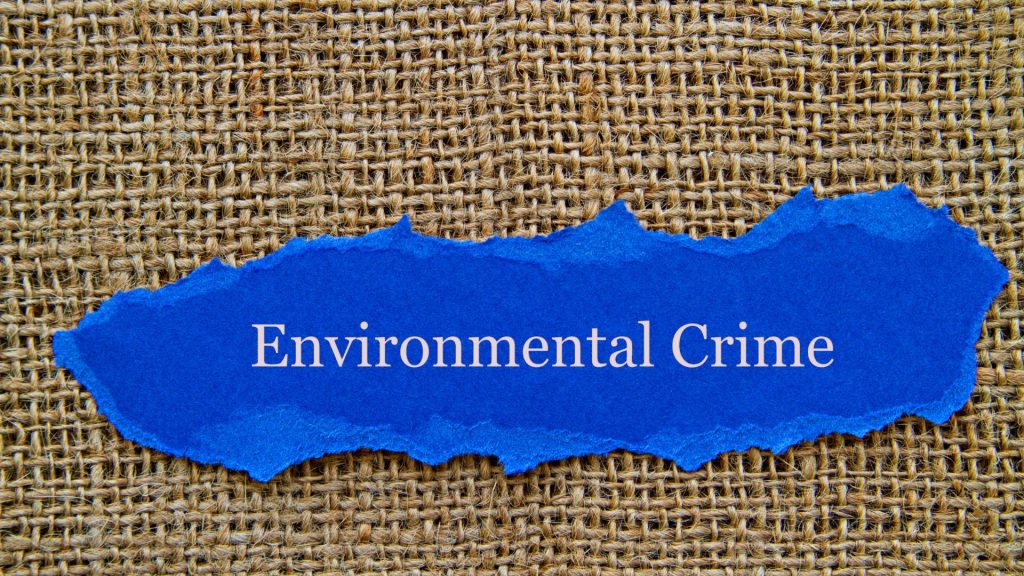There are different types of environmental crimes and it is the violation of environmental and human health laws. These laws govern air and water quality and specify how waste and hazardous materials can be legally disposed of. When environmental laws are broken, individuals or corporations can be charged with a white collar crime.
Types of Environmental Crimes
Forestry Crime
Forestry crime refers to a broad range of unlawful activities, including illicit logging and land clearing, that occur across the forestry supply chain, from harvesting to processing to sale.
Forest crime encompasses the following:
Illegal harvesting of highly valuable, endangered wood species
The laundering of illegally collected wood through agricultural and plantation front firms
Illegal logging in protected regions, on native grounds, or outside concession borders
Document fraud and misstatements in order to conceal illegal activity and tax evasion.
Illegal Logging
Illegal logging is the practice of obtaining, handling, transporting, buying or selling wood in infringement of local, national, and international laws.
Unlawful Land Clearance
Unlawful land clearance is the illegal purchase and clearing of land for agriculture, construction, or real estate speculation.
Illegal Mining
Illegal mining is defined as mining done without governmental approval, such as when there are no land rights, mining licenses, or exploration or transportation permits or when state approval is gained via corruption. This crime is mostly accompanied by forestry crimes.
One of the major environmental issues the world is currently dealing with is serious organized criminality in the forestry sector. Illegal logging endangers precious forests because it poses minimal risks and tremendous advantages in a largely uncontrolled global market for affordable timber and wood products. One of the primary crimes connected to the lumber sector is the unlawful harvesting of forests. The unlawful purchase of logging rights, the non-payment of necessary taxes, illegal mass transportation, transshipment, the use of forged papers, inaccurate customs reports, official corruption, bribery, and a number of other financial and social crimes, are additional serious offenses.
Ozone-Depleting Substances Smuggling
The ozone layer protects the earth’s surface from dangerous solar ultraviolet radiation and is necessary for all life on earth. Thinning of the ozone layer is a serious concern for humans and the environment. The Montreal Protocol has earned praise for being the most effective environmental agreement. However, once control measures started to take effect, legislators responsible for crafting the treaty did not anticipate the prospect of an illegal ODS trade. By the middle of the 1990s, the proliferation of Chlorofluorocarbons smuggling posed a threat by slowing the demand for substitute chemicals, perhaps delaying the ozone layer’s recovery. Illegal trafficking increased immediately after the phase-out of CFC manufacturing began in the EU and the US in 1995.
Illegal, Unreported, and Unregulated Fishing
Illegal, unreported, and unregulated or IUU fishing harms genuine fishermen’s livelihoods, exacerbates overfishing, and depletes livestock. The preservation of marine ecology and food supply security is gravely threatened.
There are three main categories of illegal fishing, which are as follows:
Illegal fishing happens when a fishing vessel transgresses national or international laws. For example, by fishing during prohibited times or for species that are protected;
Unreported fishing includes fishing operations that are not informed or are recorded incorrectly; and
Unregulated fishing includes fishing by boats whose nationality has not been declared or breaching the regulations that govern fishing in a particular region.
Millions of people worldwide rely on the seas as a major source of nutrition and work, but as fish populations are being reduced, seafood is becoming a more precious commodity. A growing number of organized, multinational criminal organizations are resorting to illicit fishing, endangering food security and coastal countries’ political, social, and economic stability. Criminals employ fishing vessels to sell narcotics and humans because their erratic navigation patterns and extended durations at sea make it simple for these ships to disappear into the maritime backdrop unnoticed. Criminal organizations frequently use large-scale commercial fishing profits to fund other illicit operations.
Waste Crime
Waste crime is the unlawful dumping or management of waste. Illicit disposal, dumping, and trafficking in garbage and chemicals related to a variety of distinct actions, including the depositing of trash and substances on communal or private property or into waterways without authorization, or consent from the competent authorities, the export and import of junk and chemicals in violation of domestic or international legislation. Large- and small-scale dumping, sometimes referred to as “flytipping,” ruins the ecology, blights the terrain and is difficult to clean up.
In the Basel Convention, the term “wastes” refers to materials or items that are disposed of, planned for disposal, or required to be disposed of in accordance with national laws.
Waste includes a very broad range of materials that have been dumped, including industrial, agricultural, municipal, electrical, and electronic items, as well as novel kinds like fake pesticides. It encompasses any size or scope, including abandoned ships, liquid or oil trash, millions of cell phones, and even billions of worn auto tires.
In 2011, the UNEP estimated that the global market for garbage produces 410 billion US dollars annually, omitting a sizeable informal economy from collection through recycling. There is an opportunity for criminal activity at various phases of lawful business, just like in any significant economic sector.
Based on international, regional, and national investigations, as well as media and non-governmental organizations’ reporting, some wastes can be recognized as more prone to be connected to waste crimes. They include the following:
Electronic Waste or E-Waste: Computers, mobile phones, televisions, refrigerators, and other electrical and electronic devices all fall under the broad category of “e-waste.” Due to the inclusion of dangerous substances, including lead, mercury, and brominated flame-retardants, electronic waste is mostly classified as hazardous. Additionally, valuable metals like copper, gold, and nickel and scarce elements with strategic importance, like indium and palladium, may be found in e-waste. These important sources of secondary raw materials may be obtained by recovering, recycling, and using these precious and heavy metals. E-waste is known to be transported to underdeveloped nations where it is frequently not treated in an environmentally friendly way, posing a major hazard to the environment and human health.
Mixing Hazardous Waste with Non-Hazardous Waste: Unreliable waste handlers may find it enticing to mix dangerous and non-dangerous garbage to avoid paying more for categorization or treatment. Europol examines the unlawful practice of mixing inferior gasoline with hazardous waste from illicit petrol manufacturing in Threat Assessment in 2013 on Environmental Crime in the EU. Instead of being investigated as environmental crime, this offense is typically explored as fraud.
Used Lead-Acid Batteries or ULAB: One of the most recycled consumer goods globally is used lead-acid batteries, also known as spent lead-acid batteries, from automobiles. Due to the Basel Convention’s classification of used lead-acid batteries as hazardous waste, their import and export are subject to its restrictions. The batteries, however, are illegitimately shipped to nations with weaker treatment requirements and frequently passed off as non-hazardous metal debris or plastic waste.
Obsolete Fake Pesticides: According to an analysis of counterfeit goods, counterfeit pesticides may include unidentified toxic materials that pose a risk to human and environmental health. These toxins endanger farmers, the food supply chain, and consumers when hazardous goods are released onto the market. Some of the false pesticides can contaminate the soil over time, harming next crops, groundwater, surface water, and nearby reservoirs.
Final Thoughts
Environmental law violators are typically sentenced to criminal fines, probation, jail time, or a combination of these penalties. While jail time is the most severe punishment for environmental crimes committed by individuals, fines are intended to deter large corporations from violating environmental laws and regulations. Without the threat of severe financial penalties, some corporations may conclude that noncompliance is more cost-effective than following the law. Environmental crime fines are intended to offset the financial allure of illegal dumping.



